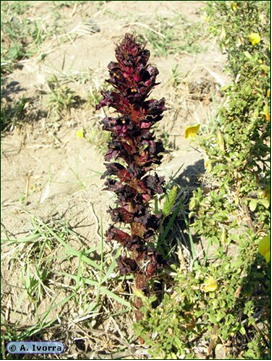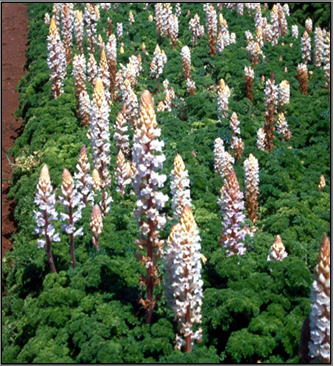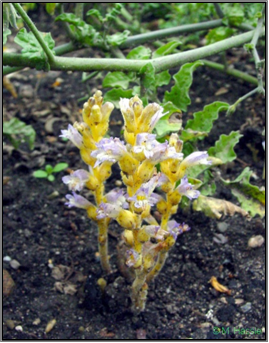CGKB News and events Management strategies
Weeds - faba bean
Contributors to this section: ICARDA, Syria (Siham Asaad, Abdulrahman Moukahal).
|
Contents: |
Scientific names
Orobanche foetida Pers.
Orobanche crenata Forsk.
Orobanche ramosa L.
Significance
Yield reductions of 30 to 70% are not uncommon. International markets may reject broomrape-contaminated produce.
Symptoms
The appearance of the parasite itself is the most diagnostic feature of infestation. The parasite has erect, branched or unbranched aerial flowering shoots. The leaves are reduced to scales and are disposed alternatively. The shoots bear bisexual tubular flowers in a spike. The tiny seeds are produced in enormous numbers in capsules.
Hosts
Broomrapes usually parasitic only broadleaved plants but there are a few records of attacks on monocots (grasses, etc.). Branched broomrape attacks many crops and common weeds. Non-host crops can support infestations because of their weed component, and the produce of such crops may carry broomrape seeds. Some broomrape species have specialized biotypes or races. Plants of the same species attack different sets of hosts in different geographic areas. Susceptibility to attack also depends on the cultivar or genetic characteristics of a particular crop. The plants attacked by branched broomrape around the world include:
Crops: bean, broad bean, cabbage, capsicum (peppers), canola, carrot, cauliflower, celery, chickpea, clovers, eggplant (aubergine), flax, hemp (cannabis), hops, lentil, medics, onion, parsnip, paprika, pea, pyrethrum, sunflower, tobacco, tomato, potato.
Geographic distribution
Western and Central Asia (especially in Afghanistan, Syria, Egypt, India, Iran, Jordan, Lebanon, Morocco, Pakistan, Saudi Arabia, Australia, Europe (especially the Mediterranean), N. Africa, N. America.
Biology and transmission
Seeds germinate in moist soil at 18 to 23° C and require moist soil for one week to become established. The roots parasitic the roots of host plants for 40 to 50 days. Stems emerge in spring and are visible for only about 3 weeks from the end of September through to October. Flowering is rapid, within 6 to 9 days after stem emergence, with a similar period between the cessation of flowering and the ripening of fruit. An infestation may contain many plants that do not produce above-ground parts.
Dispersal from property to property and within properties in the infested area in South Australia appears to be mainly by carriage on vehicles and machinery. Seeds stick to equipment and animals that contact the plant and can also be dispersed by wind and water (including irrigation water/sprinklers), in animal manure, soil, fodder, on livestock and on footwear and clothing. Seeds attach to crop seeds and other produce. Seedlings imported from infested areas can carry seeds stuck to their leaves or in the soil. Seeds remain viable after passage through the digestive tracts of animals including cattle and goats.
Detection/indexing method in place at the CGIAR Center at ICARDA
- Filter wash test
Treatment/control
Hand weed shoots prior to their seed formation to reduce inoculum levels. This is recommended in minor infestations only.
- Sow the crop late to help plants escape the worst effects of infection.
- Plow deep to bury Orobanche seeds into deeper soil layers to reduce infestation.
- Use selective herbicides such as imazaquin (10-15 ml a.i. /ha).
- Use soil solarization to reduce soil-borne inoculum.
- Use resistant varieties, if available.
Procedure followed at the centers in case of positive test
- Mechanical cleaning, rotation
References and further reading
http://www.icarda.org/Publications/Field_Guides/Lentil/Lentil.htm#Lent7.Html
Branched Boomrape - Identification: State prohibited weed

Orobanche foetida (photo: ICARDA) |

Orobanche crenata (photo: ICARDA) |

Orobanche ramosa (photo: ICARDA) |

Orobanche egyptiaca (photo: ICARDA) |
Scientific names
Cuscuta campestris Yuncker
Cuscuta hyalina Roth.
Other scientific name
C. pentagona
Significance
The effect of field dodder on 12 legume crops was investigated in a greenhouse experiment. The legume crops showed great variations in response to field dodder parasitism. Based on the reduction in host dry weight (biological yield) caused by the parasite, faba bean lost >50% of its biological yield was considered highly susceptible.
Symptoms
The appearance of the parasite itself is the best diagnostic symptom. It has fine, yellow or orange, thread-like branches which grow and entwine around the stems and other aboveground parts of the host.
Dodder-infected areas appear as patches in the field and continue to enlarge during the growing season. In late spring and early summer, dodder produces a massed cluster of white flowers.
Infected host plants become weakened, decline in vigor and produce poor yields.
Several patches might coalesce to form large areas that can be easily recognized by the yellowish color of the parasite strands.
Hosts
C. campestrisis the most important Cuscuta species, attacking a wide (C. campestris) range of species, including vegetables, fruits, ornamentals and woody plants. It is reported as a weed in 25 crops in 55 countries.
Geographic distribution
Europe to North Africa and eastern Asia
Detection/indexing method at ICARDA
- Wash filter test
Treatment/control
- Cultural Practices: Dodder is best controlled through establishment prevention by using clean seed. Ornamental beds should be kept clean of seed-producing plants. Once dodder becomes established, eradication is almost impossible. Mechanical removal can be attempted, but once dodder has produced the haustoria it is near impossible to avoid damage to the host plant. If dodder has germinated and has attached to a host plant, removal of both is recommended to eradicate.
- Herbicide Use: Use of pre-emergent herbicides is the best chemical approach. These products must be applied prior to the germination of the seed as the small seedling root will drop off once the haustorium has formed. Dinitroanaline herbicides have been reported to be effective. Dichlobenil has also shown good results. Read all labels to ensure that the herbicides can be used around the host plants. Glyphosate has shown results as a postemergent herbicide, but its use is limited as it will also damage the host plant. Phenoxy herbicides have only shown limited control and again injury to the host plant can occur.
Procedure followed in case of positive test
- Mechanical cleaning. rotation
References and further reading
http://www.icarda.org/Publications/Field_Guides/Lentil/Lentil.htm#Lent7.Html
http://www.weedalert.com/weed_pages/wa_dodder.htm
 Dodder (photos:ICARDA) |
Best practices for the safe transfer of faba bean germplasm
Contributors to this section: ICARDA, Syria (Siham Asaad, Abdulrahman Moukahal).
In preparation
Risk management
Contact person for Risk management: Gabriel Romero, PhilRice, the Philippines.
Contributors to this section: PhilRice, the Philippines (Gabriel Romero); CGIAR IAU (John Fitzsimon); Bioversity-ILRI, Addis Ababa, Ethiopia (Alexandra Jorge); IRRI, Los Baños, Philippines (Ruaraidh Sackville Hamilton, Renato Reaño); ILRI, Addis Ababa, Ethiopia (Jean Hanson); CIMMYT, Mexico (Thomas Payne); IITA, Nigeria (Dominique Dumet); ICRISAT, Patancheru, India (Hari D Upadhyaya); NCGR USDA-ARS, Oregon, USA (Barbara Reed); NCGRP USDA-ARS, Fort Collins, Colorado (Dave Ellis).
The importance of secure conservation
Secure conservation is at the heart of Centres’ stewardship of their collections and depends on an accurate assessment and appropriate management of risks. The risks of ex situ storage in genebanks should be, on balance, less than those to which the accessions would be exposed if maintained only in the wild or in production systems. The risks are less principally because of the hands-on nature of ex situ conservation and the extent of our understanding of the behaviour of accessions under controlled conditions. Still, due to the enormous size and importance of the in-trust collections, there is compelling need to implement and promote systematic risk management that addresses the physical and biological risks in the every-day environment to which the collections and related information are exposed. Accordingly, the management of risk in the storage environment involves responsible adherence to good practices, the application of the necessary skills, and the provision of appropriate storage conditions, through targeting funds to where they will have the most impact. The adequacy of conservation technologies is key, requiring particular attention for clonal crops.
Risk management guidelines
These guidelines set out the broad principles for risk management, which are primarily based on a review of the frameworks already adopted by the CGIAR Centres. They, in turn, follow the approaches set out in the Australia/New Zealand Risk Management Standard AS/NZS 4360:1995.
This work was supplemented by:
- Further exchanges of information and feedback with Centre genebank staff;
- A tour of USDA-ARS sites for clonal crops, legumes, data management, and long-term back-up collections;
- Vulnerability reports of USDA-ARS Crop Germplasm committees.
Structuring risk management systems
The common objectives, which all the CGIAR genebanks are encouraged to use in structuring their risk management systems, are to:
- Acquire and introduce new germplasm in compliance with international standards, agreements and regulations.
- Conserve germplasm samples in a secure facility that maintains their viability.
- Distribute healthy germplasm in compliance with international standards, agreements and regulations.
- Manage and provide complete and accurate germplasm information as a global public good.
- Conduct genebank operations in an efficient and sustainable way.
Steps in the Risk Assessment and Management guidelines
The steps involved in the Risk Assessment and Management guidelines include:
| Communication and consultation |
|
|
| Establishing the context |
|
|
| Risk identification |
|
|
| Risk analysis |
|
|
| Risk evaluation |
|
|
| Risk treatment |
|
|
| Monitoring and review |
You can click directly on each of the above steps or on the risk sub menus on the left to have a detailed explanation of what to do in each step.
These guidelines are also designed to assist non-CGIAR genebanks, which are also encouraged, as part of the global system envisaged under the International Treaty, to implement a risk management system for their collections.
You can also see the full document of the guidelines below or access the risk analyis and management tools directy from this page.
Genebank Risk Management Framework guidelines (Romero GO, Fitzsimon J., 2010).
Risk assessment tools
- Generic risk assessment tool for seed crops.
- Generic risk assessment tool for clonal crops.
- Specific risk assessment tool for rice.
- Specific risk assessment tool for Musa.
References and further reading
Alconero R,
Benson EE. 2008. Cryopreservation of phytodiversity: A critical appraisal of theory & practice. Critical Reviews in Plant Sciences, 27(3): 141-219.
Calles T, Dulloo ME, Engels JMM,
CIAT Risk Management Team. 2004. Risk Management at the CIAT genebank operations. Draft report available here.
CIP Risk Management Team. 2004. Genetic Resources Risk Management in CIP. Draft report available here.
Clark RL, Shands HL, Bretting PK, Eberhardt SA. 1997. Managing large diverse germplasm collections. Crop Science, 37:1-6.
Clement SL, Griswold TL, Rust RW, Hellier BC, Stout DM. 2006. Bee associates of flowering Astragalus and Onobrychis genebank accessions at a Snake River site in
Ellis D,
Fitzsimon J. 2006.
Fitzsimon J. 2007. Conservation and Use of Genetic Resources: Risk Management. Paper presented at the GPG2/GCP Quality Management and Performance Management System Design Workshop, October 2007,
GRC Risk Management Team. 2007. Risk Matrix at the IRRI Genetic
ICARDA Risk Management Team. 2005. Risk Analysis of Genetic Resources in ICARDA. Draft report available here
ICRISAT Risk Management Team. 2007. Risk Management at ICRISAT.
IITA Risk Management Committee. 2008. Risk Assessment Report at IITA. Available here
INIBAP Risk Management Team. 2008. Risk Assessment Report at INIBAP Musa Genebank. Available here.
Panis B, Thinh NT. 2001. Cryopreservation of Musa germplasm. In: Escalant, Sharrock S, editors. JVINIBAP Technical Guideline 5. International Network for the Improvement of Banana and Plantain.
Rao NK, Hanson J, Dulloo ME, Ghosh K, Nowel D, Larinde M. 2006. Manual of seed handling in genebanks. Handbooks for Genebanks No. 8. Bioversity International, Rome, Italy. Available in English (1.5 MB), Spanish (1.4 MB) and French (1.9 MB).
Reed BM, Engelmann F, Dulloo ME, Engels JMM. 2004. Technical guidelines for the management of field and in vitro germplasm collections. IPGRI Handbooks for Genebanks No. 7. International Plant Genetic Resources Institute,
USDA Forage and Turf Grass Crop Germplasm Committee. 1997. Crop vulnerability statement for forage and turf. (Can be obtained from Blair L. Waldron [This email address is being protected from spambots. You need JavaScript enabled to view it.]).
USDA Maize Crop Germplasm Committee. 2000. Maize report and vulnerability statement. http://www.ars-grin.gov/npgs/cgc_reports/maizecgc.html.
USDA Potato Germplasm Committee. 2004. Genetic vulnerability in potato. (Can be obtained from John Bamberg [This email address is being protected from spambots. You need JavaScript enabled to view it.]).
USDA Rice Germplasm Committee. 2004. Crop vulnerability statement for rice. http://www.ars-grin.gov/npgs/cgc_reports/CropVulnerabilityRiceRevised.pdf.
USDA Sorghum and Millet Crop Germplasm Committee. 2004. Sorghum and millet vulnerability statement. (Can be obtained from Gary C. Peterson [This email address is being protected from spambots. You need JavaScript enabled to view it.]).
USDA Sweetpotato Crop Germplasm Committee. 2001. Sweetpotato germplasm acquisition, maintenance and evaluation priorities 2001-2006. (Can be obtained from G. Craig Yencho [This email address is being protected from spambots. You need JavaScript enabled to view it.]).
USDA Vigna Crop Germplasm Committee. 2004. Vigna germplasm: Current status and future needs. http://www.ars-grin.gov/npgs/cgc_reports/vignarpt2004.pdf.
USDA Wheat Crop Germplasm Committee. 1996. Wheat vulnerability report. http://www.ars-grin.gov/npgs/cgc_reports/1996_wheatcgc_report.pdf.
Risk assessment
Contributors to this section: PhilRice, Philippines (Gabriel Romero); CGIAR IAU (John Fitzsimon); Bioversity-ILRI, Addis Ababa (Alexandra Jorge); IRRI, Los Baños, Philippines (Ruaraidh Sackville Hamilton, Renato Reaño); ILRI, Addis Ababa (Jean Hanson); CIMMYT, Mexico (Thomas Payne); IITA, Nigeria (Dominique Dumet); ICRISAT, Patancheru, India (Hari D Upadhyaya); NCGR USDA-ARS, Oregon, USA (Barbara Reed); NCGRP USDA-ARS, Fort Collins, Colorado (Dave Ellis).
Communication and consultation
Everyone involved in implementing a risk management system should be oriented in the concepts, methodology, terminology, documentation requirements and decision-making processes of the system. This should happen for all those involved at the inception of the system, and thereafter for those who come after and are new to the system. That communication process should also allow for suggestions for improvement.
The risk assessment process itself begins with the consideration of the objectives of the genebank, the environment in which the activities operate and the stakeholders.
Objectives
A complete analysis of all activities' relevant risks is most likely if their identification is explicitly linked, in the same way that performance indicators of the activity should be, to the agreed objectives of the activity. The common objectives, which all the CGIAR genebanks are encouraged to use in structuring their risk management systems, are to:
- Acquire and introduce new germplasm in compliance with international standards, agreements and regulations.
- Conserve germplasm samples in a secure facility that maintains their viability.
- Distribute healthy germplasm in compliance with international standards, agreements and regulations.
- Manage and provide complete and accurate germplasm information as a global public good.
- Conduct genebank operations in an efficient and sustainable way.
Environment
Genebank activities are affected by various factors in the environment. Those elements that might support or impair the genebank’s ability to achieve its objectives and functions should be identified as part of the risk management process. These could be related to such factors as:
- The strategic focus and existing or planned portfolio of the Centre.
- People (staff, consultant, partners).
- The available physical infrastructure.
- Financial resources.
- Legal compliance requirements.
- Technology.
- Existing internal processes.
- Developments in the external environment such as political changes.
These factors may be controlled to different degrees. An understanding of the environment can help determine the proper response to the risks identified in the risk assessment.
Stakeholders
There is a wide range of stakeholders that have an interest in the sustainable operations, products and services of CGIAR genebanks, such as:
- Researchers (breeders, geneticists, agronomists, physiologists, pathologists, entomologists).
- Farmers.
- Private sector.
- Host country.
- Other CGIAR Centres.
- International crop networks.
- Donor community.
The perceived effects and impact of failure of genebank services to stakeholders can help to evaluate the importance of risks and guide the development of necessary mitigation with due consideration of the stakeholders.
More Articles...
- Risk identification and analysis
- Risk evaluation
- Decision support tool
- Guide for users
- Evaluating the Cost-Effectiveness of Collection Management: A Methodological Framework
- Overview: Testing tissue-culture material of clonal crops for pests
- Pest list identification and prioritization
- Testing
- Diagnostic protocols for sweet potato germplasm
- Viruses - sweetpotato
Subcategories
-
main
- Article Count:
- 11
-
Stog
- Article Count:
- 2
-
Stog-rice
- Article Count:
- 7
-
Stog-sorghum
- Article Count:
- 11
-
Stog-common-bean
- Article Count:
- 10
-
stog-forage-legume
- Article Count:
- 10
-
stog-forage-grass
- Article Count:
- 11
-
stog-maize
- Article Count:
- 9
-
stog-chickpea
- Article Count:
- 10
-
stog-millets
- Article Count:
- 12
-
stog-barley
- Article Count:
- 10
-
stog-groundnut
- Article Count:
- 9
-
stog-pigeon-pea
- Article Count:
- 8
-
stog-wheat
- Article Count:
- 10
-
stog-lentil
- Article Count:
- 9
-
stog-cowpea
- Article Count:
- 10
-
stog-faba-bean
- Article Count:
- 9
-
risk management
- Article Count:
- 4
-
decision support tool
- Article Count:
- 3
-
stog-clonal
- Article Count:
- 23
-
developing strategies
- Article Count:
- 4




